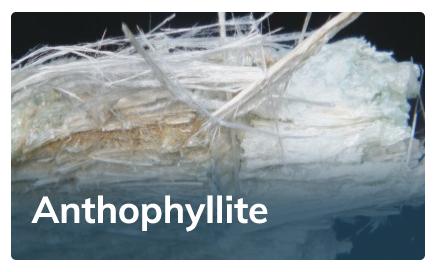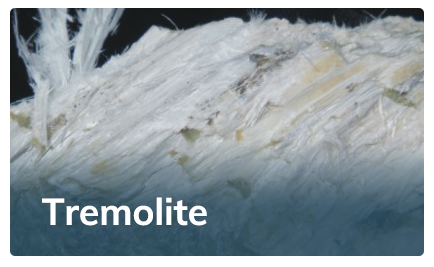01. Asbestos Types
What Are the Types of Asbestos?
Asbestos is classified in six unique types:
- Chrysotile asbestos
- Amosite asbestos
- Crocidolite asbestos
- Actinolite asbestos
- Anthophyllite asbestos
- Tremolite asbestos
All asbestos occurs naturally in underground deposits. The Environmental Protection Agency (EPA) officially classifies the six asbestiform varieties in the Asbestos Hazard Emergency Response Act (AHERA).
Asbestos fibers can easily become airborne when disturbed. This can happen during use of asbestos products, mining for asbestos or during normal job duties in industries where asbestos was used. Fibers can also become airborne during natural disasters, renovations or demolition.
Once airborne, individuals are susceptible to inhale the dangerous asbestos fibers. This can lead to dangerous diseases, such as mesothelioma and lung cancer.
Efforts to ban the mineral began in the 1980s. In 1989, the EPA attempted to ban all asbestos-containing products, but the ban was overturned. However, mining in the United States has stopped. The last U.S. asbestos mine, located in California, closed in 2002.
As of 2023, chrysotile asbestos was the only type actively used in the United States. In 2024, the EPA finalized a rule to ban chrysotile asbestos nationwide. The rule does not amount to a full ban but is a step in the right direction.
02. Dangers of the Asbestos Types
Are All Types of Asbestos Dangerous?
Exposure to any type of asbestos is dangerous. Researchers have found even one-time or minimal exposure poses health risks. Various organizations and health agencies have classified asbestos as carcinogenic, including the EPA and the International Agency for Research on Cancer (IARC).
Exposure to any type of asbestos can cause a number of asbestos-related diseases, including mesothelioma, asbestosis and lung cancer.
All types of asbestos are made up of microscopic fibers. The small, sharp fibers may embed in different parts of the body, including organs and the tissues surrounding them. Because the body has no way of getting rid of the fibers, they remain embedded and may eventually lead to mesothelioma or another disease.
Individuals who believe they have been exposed to asbestos in the past should speak to their doctor. A healthcare professional can help monitor for any signs or symptoms of mesothelioma.
Serpentine Asbestos vs. Amphibole Asbestos
The types of asbestos are categorized into two main families: amphibole and serpentine. All types of asbestos are fibrous and composed of hundreds of small silica fibers. The shape of these fibers determines their family.
Serpentine asbestos is recognized by its wavy or curly form, shaped much like a serpent. The fibers are also long and pliable. Serpentine asbestos may also be classified as “sheet silicates” as the fibers form layered sheets. The only member of this family is chrysotile asbestos.
Chrysotile was the most heavily used asbestos type in the United States. It can be found in many buildings, homes and schools. Asbestos abatement professionals can perform any air sampling and monitoring in these locations. They should be hired to remove or encapsulate any asbestos found on site.
Amphibole asbestos features straight, stiff, needle-like fibers. Some studies suggest these features make amphibole asbestos more dangerous than serpentine asbestos. This is because the fibers are easier to inhale. Asbestos types that fall under the amphibole category include amosite, crocidolite, actinolite, anthophyllite and tremolite.
Crocidolite is considered the most hazardous amphibole asbestos type because the fibers are extremely small. It was less commonly used but gained attention during the 1950s for its use in Kent Micronite cigarette filters.
Resources for Mesothelioma Patients
03. Chrysotile
Chrysotile Asbestos

Chrysotile is the only type of asbestos that falls into the serpentine category. Chrysotile asbestos is made up of long, curly fibers that weave to make sheets. It is also called “white asbestos” because of the color of the asbestos fibers.
Chrysotile is the most commonly used type of asbestos in the United States. It’s estimated to account for 90% – 95% of asbestos used in building construction in the United States. In previous decades, it was also widely manufactured and used in Canada. This form of asbestos was popular in construction products and automotive parts, such as brake shoes.
04. Amosite
Amosite Asbestos

Amosite asbestos is light brown and straight in appearance. It is also referred to as “brown asbestos.” It is made of thin, needle-like fibers that are easily inhaled when disturbed. It is considered one of the most hazardous forms of asbestos.
Amosite asbestos has a particularly high level of heat resistance. As a result, this type of asbestos was commonly used in products such as insulation and ceiling tiles. It was the second-most common type used in the United States, after chrysotile. Research suggests around 5% of asbestos building materials used in the United States contained amosite asbestos.
05. Crocidolite
Crocidolite Asbestos
 Crocidolite asbestos is also known as “blue asbestos.” Of the types of asbestos in the amphibole family, it’s known to be the most hazardous. This is because the small size of the crocidolite fibers can make them easier to inhale.
Crocidolite asbestos is also known as “blue asbestos.” Of the types of asbestos in the amphibole family, it’s known to be the most hazardous. This is because the small size of the crocidolite fibers can make them easier to inhale.
Some studies have shown crocidolite asbestos is responsible for more diseases and deaths than other types.
This mineral features a lower heat resistance than other main types of asbestos. As a result, it was less commonly used. However, it could occasionally be found in some construction materials. One of its most notable uses was in Kent Micronite cigarette filters from 1952 to 1956.
06. Actinolite
Actinolite Asbestos
 Actinolite asbestos is typically darker in color than other common types of asbestos. It can range from white or pale yellow to dark gray or green. It features long, sharp fibers that may easily be inhaled.
Actinolite asbestos is typically darker in color than other common types of asbestos. It can range from white or pale yellow to dark gray or green. It features long, sharp fibers that may easily be inhaled.
This type of asbestos contains other minerals including iron, magnesium, calcium and silicon. It’s slightly rarer than other types of asbestos.
As such, this form of asbestos isn’t found as often in consumer products. However, trace amounts of it have been found in vermiculite. Zonolite insulation made from vermiculite was popular in attics.
07. Anthophyllite
Anthophyllite Asbestos
 Anthophyllite asbestos is yellowish-brown in color. This form is composed primarily of magnesium and iron.
Anthophyllite asbestos is yellowish-brown in color. This form is composed primarily of magnesium and iron.
Like other types of amphibole asbestos, anthophyllite asbestos features long, needle-like fibers that are easily inhaled.
Anthophyllite asbestos is rarer than other types of asbestos and much less common in consumer products. It has occasionally been found in some cement and insulation materials.
08. Tremolite
Tremolite Asbestos
 Tremolite asbestos can range in color from white to dark green and features long, sharp fibers. This type of asbestos was commonly used in insulation and other construction materials.
Tremolite asbestos can range in color from white to dark green and features long, sharp fibers. This type of asbestos was commonly used in insulation and other construction materials.
Testing of talc and vermiculite has often shown trace amounts of tremolite asbestos. For instance, testing of various cosmetic products sold at Claire’s© found tremolite asbestos contamination. This sparked concern as these makeup products are marketed to children.
Tremolite asbestos also contaminated the vermiculite mines in Libby, Montana, which led to widespread exposure in the city. This type of asbestos may also be referred to as Libby Asbestos or LA.
09. Other Minerals
Other Minerals That May Contain Asbestos
Asbestos may be found in other minerals, including talc and vermiculite. In the process of mining these minerals, their proximity to naturally occurring asbestos can result in contamination. This poses a potential health risk to workers and consumers.
10. Common Questions
Common Questions About Types of Asbestos
-
How are the different types of asbestos identified and distinguished from each other?
The six different types of asbestos are often distinguished by color and shape:
- Chrysotile asbestos: White with long, curly fibers
- Amosite asbestos: Brown with straight, needle-like fibers
- Crocidolite asbestos: Blue with short, sharp fibers
- Actinolite asbestos: Darker in color with long, sharp fibers
- Anthophyllite asbestos: Yellowish-brown with long, needle-like fibers
- Tremolite asbestos: Ranges from white to dark green, with sharp fibers
-
What are the different asbestos colors?
Individuals may hear asbestos named by different colors. The three main types of asbestos U.S. citizens should be aware of are crocidolite (blue asbestos), amosite (brown asbestos) and chrysotile (white asbestos).
-
Which types of asbestos are most commonly found in homes and buildings?
Chrysotile asbestos is the most common asbestos type used in building construction. About 90% – 95% of asbestos in buildings is believed to be chrysotile. It was often used in cement, asphalt and roof sealants. Amosite is the next most common type used in homes and buildings, making up about 5% of asbestos-containing materials. Amosite is often found in insulation, pipe fittings and structural steel.
-
Are there any regulations or laws related to the use of asbestos in products or buildings?
Government organizations began passing laws regulating asbestos in the 1970s. But the United States still does not have a complete asbestos ban. Because asbestos products may still be in older buildings, the National Emission Standards for Hazardous Air Pollutants (NESHAP) require an asbestos inspection be done before renovating, repairing or demolishing buildings.









